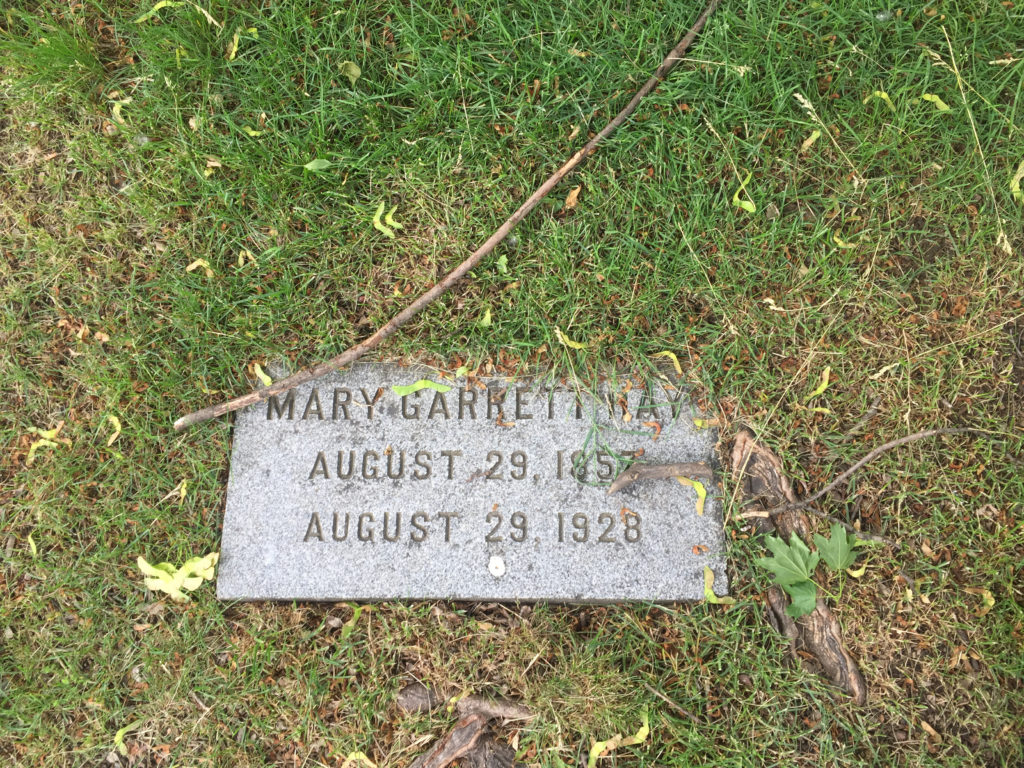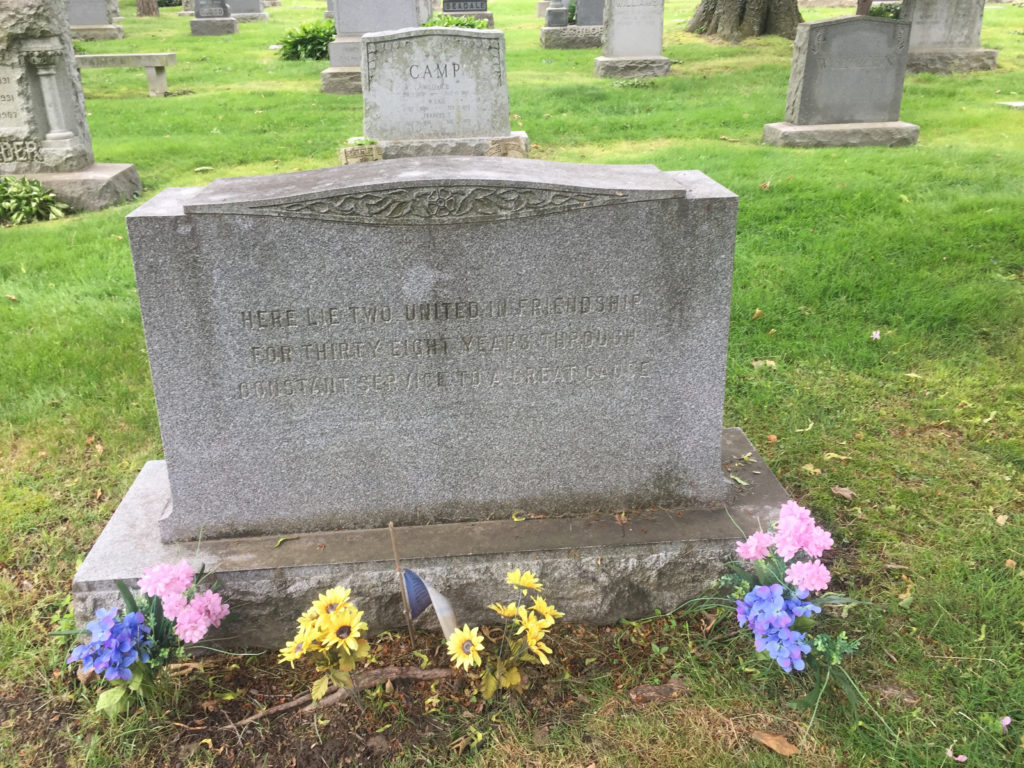Erik Visits an American Grave, Part 915
This is the grave of Carrie Chapman Catt.

Born in 1857 in Ripon, Wisconsin (a town famous for hosting the founding of the Republican Party just three years earlier), Carrie Lane grew up in Charles City, Iowa. Despite it being quite uncommon to send girls on to higher education, her parents were sort of supporters of her and she went to college at what is today Iowa State University in 1877. Her father had the money to pay for it, but he wasn’t convinced that sending a daughter to college was a good idea, so he only paid part of it and forced her to work for cover the rest of it. So she spent her college years working in low-level jobs, not unlike a lot of students today. While at what was then Iowa Agricultural College, she pushed for women’s full participation in college life, including participating in the military drills required of men.
After Catt graduated in 1881, she was a law clerk for a bit and then became superintendent of schools in Mason City, Iowa, which really was a remarkable position of power for any woman in the 1880s, not to mention one in her 20s. She left that when she married a newspaper editor named Leo Chapman in 1885. He went to California to make money, she heard he was sick and started on her way, but he was dead before she arrived. Since she was in San Francisco, she stuck around for a couple of years working on newspapers, but then came back to Iowa. She soon married George Catt, a rich engineer and reformer. By the mid-1880s, Carrie Chapman Catt was already deeply involved in the fight for women’s suffrage. George Catt was a big supporter of this and encouraged her to be on the road much of the year leading that fight. They were married for 15 years before George Catt died in 1905.
By the early 1890s, Catt was working for the National American Women’s Suffrage Association (NAWSA), which was Susan B. Anthony’s organization. She soon became one of the leaders, managing the failed suffrage election in South Dakota in 1892 and then the successful one in Colorado in 1893. That was the first state to grant women the right to vote by the popular vote, which meant all men. This made her the most important of the new generation of suffragists. The older generation–Anthony and Elizabeth Cady Stanton were very much still around. In fact, when Stanton wrote The Woman’s Bible, which rejected Christian ideology of female inferiority to men, it was Catt who led the charge to distance the organization from its founding mother.
Anthony chose Catt to replace her as NAWSA head in 1900. She led it for five years, stepping down when her second husband got sick and then died. During that period, the advances of the 1890s stalled out, with failed votes in Oregon and New Hampshire for suffrage. She attempted to globalize the movement as well, calling for a 1902 convention of global suffrage activists that became the International Woman Suffrage Alliance. There were a lot of bad racial politics in the women’s suffrage movement, but Catt attempted to move beyond this and to welcome Black members. When southern delegates expressed outrage over the fact, Catt stated:
We are all of us apt to be arrogant on the score of our Anglo-Saxon blood but we must remember that ages ago the ancestors of the Anglo-Saxons were regarded as so low and embruted that the Romans refused to have them for slaves. The Anglo-Saxon is the dominant race today but things may change. The race that will be dominant through the ages will be the one that proves itself the most worthy…. Miss Kearney is right in saying that the race problem is the problem of the whole country and not that of the South alone. The responsibility for it is partly ours but if the North shipped slaves to the South and sold them, remember that the North has sent some money since then into the South to help undo part of the wrong that it did to you and to them. Let us try to get nearer together and to understand each other’s ideas on the race question and solve it together.
This is a limited statement for sure. But it’s also one that made her a relative racial progressive for these women at this time. It should be stated that it took Catt awhile to get there. Earlier in her career, she was as racist as anyone in the country, with especially strong anti-immigrant beliefs that she spoke on publicly. And when the 19th Amendment was up for ratification in Tennessee, Catt stated publicly that interracial marriage was “an absolute crime against nature.” Take this for what you will–the Amendment would not have passed in Tennessee had it had any whiff of racial progressivism but Catt also unquestionably believed this. On the other hand, she explicitly shot down the idea of including the word “white” in the 19th Amendment. Again, the past is complicated.
Anyway, we are getting ahead of ourselves here a bit. Between 1905 and 1915, Catt was unquestionably a major player in women’s suffrage. But she was out of official power. She also found a new personal partner–Mary Garrett Hay, a fellow fighter for suffrage. Were Catt and Hay in a sexual relationship? It’s hard to know and this is why it is hard and often fruitless to point to a queer history of elites in a world where sex wasn’t talked about much (among the working class that queer history is often much clearer because of police reports). Maybe it doesn’t matter. We do know these two women were deeply devoted to each other and they loved each other. The contours of that love are less clear. But they were definitely partners for their rest of their lives. And maybe that’s enough without us speculating on the sexuality of people a century ago.
In 1915, Catt again took over as NAWSA president. She would lead to its final victory in 1920. As the 1910s went on, the movement began to gain success pretty quickly and more states opened the vote to women. That included New York, the first non-western state to do this, in 1917. That was a sea change moment. Moreover, even though many of the women were pro-peace, she worked it so that the NAWSA vocally supported American entry into World War I, hoping to connect women’s suffrage with patriotism. This was a morally compromised position but one that Catt never rejected. It also worked. After a hard struggle, Tennessee was the key state to pass the 19th Amendment in 1920.
With the suffrage fight over, Catt went into semi-retirement from women’s suffrage. She did help found the League of Women Voters in 1920. She traveled a good bit to promote women’s suffrage around the world, as a senior figure more than a key organizational component of the movement. Instead she became a key part of the international peace movement, founding the National Committee on the Cause and Cure of War, which she headed from 1924-32. To her great credit, she publicly called for the United States to loosen its immigration laws after 1933 to help Jews escape Nazi Germany. This was a big switch from her earlier restrictionist politics. As the U.S. entered World War II, she knew the peace caused had failed, but also that the Nazis must be stopped. She was also pretty old by this time. She died of a heart attack in 1947, at the age of 88.
Carrie Chapman Catt is buried in Woodlawn Cemetery, The Bronx, New York.
As you can see, Catt chose to be buried with Hay rather than her first husband (second husband’s body was donated to science) and as Hay had died in 1928, this was Catt’s doing, the sign of a long and loving relationship.


If you would like this series to visit other women from the suffrage fight, you can donate to cover the required expenses here. Ida B. Wells is in Chicago and Lucy Stone is in Boston. Previous posts in this series are archived here.
